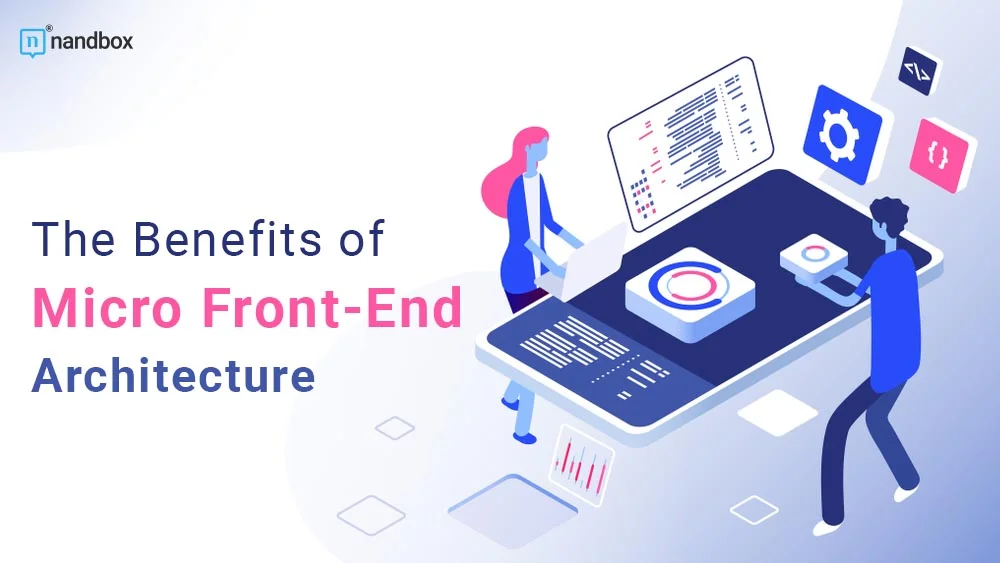Software development is an ever-changing landscape because there are always new approaches to keep up with new technologies. One of the recent methodologies that became popular in 2016 is the micro front-end architecture. This article explores micro front-end architecture, when to use it, and its benefits.
What is Micro Front-End?
Nowadays, software development, specifically web applications, relies more on the front end than before. Because of that, it’s becoming harder to rely on monolithic architecture.
Monolithic architecture is the traditional approach to treating a software program as one block, independent from other applications. It worked in the past, but now it’s too clunky to work on one big codebase.
That’s why the demand for change birthed the micro front end, an approach to breaking down the monolithic block into small apps working independently.
Think of microservices, where backends are divided into small services and treated separately, often coordinated through a microservices API gateway. Microfront-ends are more or less similar to microservices but are widely used for web applications. The API gateway in microservices acts as a single entry point for various services, managing requests and facilitating communication. Similarly, micro front-ends can utilize such gateways to streamline interactions between the smaller front-end applications, enhancing performance and security.
Types of Microfrontends
- Monorepository: In this case, one repository contains all the projects.
- Multirepository: Each project is in a separate repository where the team working on it works independently.
- Metarepository: It combines those techniques with both one folder for each project and one folder containing all of them.
Microfront-ends can also be divided according to the teams’ approach to working on them. Either one team works on one feature from start to finish, or different teams share their expertise while working on one feature.
When to Use the Micro Front-End Architecture
The micro front-end architecture is most suitable when building an application with many features. For example, a community app will have many features that can be developed separately. If the app needs to be scaled up later on, it’s also a good idea to apply this approach.
It’s noteworthy that the micro front-end architecture is more suitable for web apps than native apps. That’s because web apps can be separated, whereas native apps are harder to disassemble, making the monolithic architecture the only option.
When Not to Use It
- If it’s unclear which team is more suitable for which part of the project, it’s a better idea to stick with the monolithic technique. Imagine if you assign the wrong team to a particular feature; they might not do the job correctly, and you will end up reassigning and starting over or moving forward with a flawed product.
- It’s also better not to use this architecture when developing a small project, as it will complicate the whole process. Sometimes, when there aren’t many features to break down, the monolithic architecture will do just fine.
Benefits of the Micro Front-End Architecture
1. It Cuts Development Time
With the traditional monolithic approach, the teams work on one feature after another. It takes time for them to finalize all the features and finish developing the app. With a micro front end, each team can work on a feature separately and simultaneously, cutting development time by more than half. Not only will the app developers release the app in a shorter time, but they will also feel more productive and enthusiastic.
2. It Separates Codebases
Using micro-front-end architecture, code is divided into small, manageable pieces instead of one block. That makes it much easier and more efficient for the teams to write, test and deploy the code.
3. It Makes Work More Flexible
Because the teams will work on features separately, they can use the tech stack they prefer. They don’t all have to stick to the same rules. It gives them freedom and flexibility, keeping them invested in the project. Plus, it gives them room to be innovative and use new technologies.
4. Apps Are More Scalable
Breaking the app into smaller pieces makes it easier to scale them up. The developers can make changes to parts separately without affecting the app’s speed.
Scalability is crucial, as many app developers had to shut down their apps because they failed to make room for their growing user base.
5. Mistakes Don’t Affect the Whole App
With app development, there are bound to be coding mistakes that lead to bugs. Because testing can’t include all devices in the world, sometimes there are errors that happen because of bugs. Luckily, because the app is broken down into separate parts, the bugs in one of them won’t affect the rest of the app and user experience, and fixing it will be easier.
6. It Supports Technology Agnosticism
Technology agnosticism means that there’s no one superior tech approach that solves all the clients’ programs. Technology-agnostic developers are unbiased and open to trying different approaches and frameworks. Since the codebases are broken down into separate pieces, several programming languages, and frameworks can be used without worrying about structuring them.
7. Apps Are Easier to Update
Not only are apps easily scaled up, but they are also easier to update than apps made using the monolithic approach. Updates usually involve making changes to one feature at a time; the developer can make these changes without stopping or slowing down the rest of the app. Moreover, if the developers want to change every app feature, they can do it concurrently and save time.
9. Teams Can Work Independently
The truth is, a conflict between teams, whether developers teams only or designers too, can bring down a project at worst and hinder it at best. However, with the micro front end, each team can work autonomously. This can be achieved with one-functional teams or cross-functional teams. The cross-functional team will improve communication between developers and designers.
Final Words
The micro front-end architecture is suitable for custom-developed web apps. However, custom apps aren’t the only development method, as recently, no-coding app-building platforms have emerged. These platforms allow the app owner or any user, known as a citizen developer, to build the app themselves, using simple drag-and-drop approaches. They don’t have to acquire technical knowledge about codebases and architectures to build apps.
While many app builders on the market help users create capable web apps, only the nandbox no-code app builder enables app creators to build native apps with full capabilities and outstanding performance. Sign up to try it for free now!






